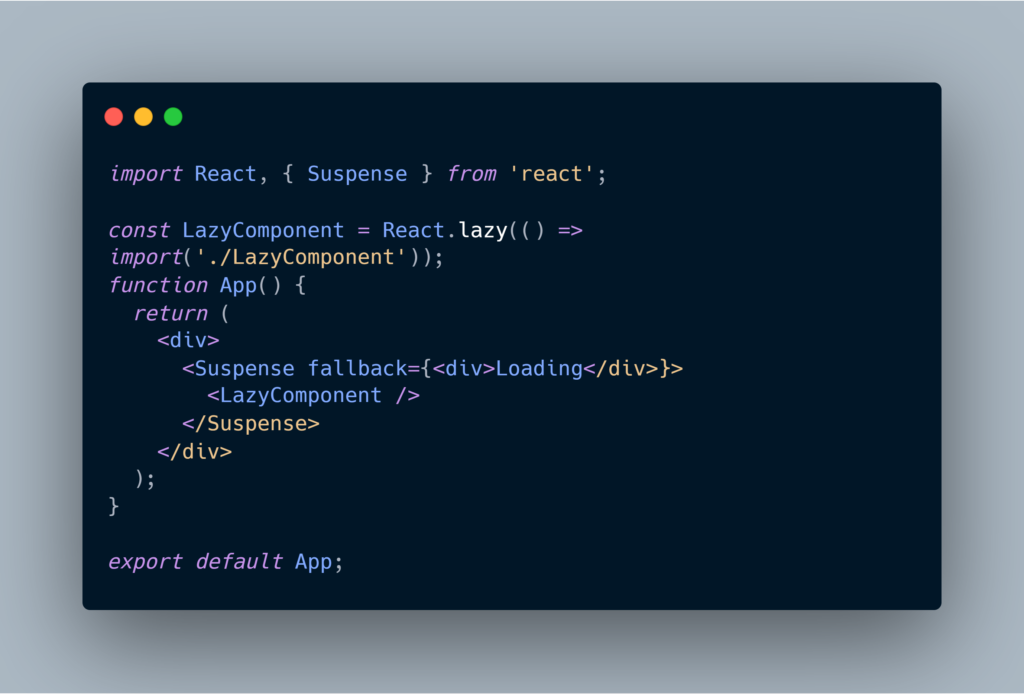As React developers, we’re constantly seeking ways to optimize our applications, and one powerful technique at our disposal is dynamic imports. Here, we’ll dive into the world of dynamic imports in React and explore how they can help us achieve faster load times and more efficient code splitting.
Understanding Code Splitting
Before we delve into dynamic imports, let’s take a moment to understand the concept of code splitting. Code splitting is a technique that allows us to split our JavaScript bundles into smaller, more manageable chunks. Instead of loading all the JavaScript code for our entire application upfront, we can load only the code that is needed for a specific route or feature when it is requested.
This approach offers several benefits:
- Faster Initial Load Times: Smaller initial bundles mean quicker load times for your application, which is crucial for retaining user engagement.
- Reduced Network Payload: Smaller bundles result in reduced data transfer over the network, which is especially important for users on slow or limited connections.
- Optimized Caching: Smaller bundles are more likely to be cached by the browser, further improving load times for returning users.
- Improved Developer Experience: Smaller bundles are easier to manage and debug, making development more efficient.
Enter Dynamic Imports
Dynamic imports are a feature provided by JavaScript that allows us to load modules (chunks of code) asynchronously at runtime. In the context of React, dynamic imports enable us to implement code splitting by loading components, libraries, or other resources only when they are needed.
Here’s a basic syntax example of how dynamic imports work in React using the import() function:

In this example, TheComponent will be loaded asynchronously when it is first rendered in your application. This is particularly useful for optimizing the loading of route-specific components or large third-party libraries.
React.lazy() and Suspense
To handle dynamic imports in React, you can use React.lazy() in combination with the Suspense component. React.lazy() allows you to create a new component that loads a dynamic import, while Suspense lets you specify a fallback UI to display while the import is loading.

Named Exports
You can also use named exports with dynamic imports, allowing you to import specific functions, components, or variables from a module.

Use Cases for Dynamic Imports
Dynamic imports can be applied in various scenarios to enhance the performance of your React application:
- Lazy Loading Routes: Load route-specific components only when the user navigates to them. This minimizes the initial bundle size and speeds up the initial page load.
- Reducing Third-party Library Size: If you’re using a large third-party library, consider dynamically importing only the parts of the library you need. This can significantly reduce your bundle size.
- Optimizing Image Loading: Load images on-demand as users scroll through a page to minimize the initial load time.
- Conditional Component Loading: Load components based on user interactions or conditions, such as displaying a modal dialogue when a user clicks a button.
Considerations and Best Practices for Dynamic Imports
While dynamic imports are a powerful tool, there are some considerations and best practices to keep in mind:
- Error Handling: Be sure to handle any errors that may occur during dynamic imports to provide a graceful fallback or user-friendly error messages.
- Performance Monitoring: Use tools like Lighthouse, Webpack Bundle Analyzer, and Chrome DevTools to monitor and optimize your bundle sizes and loading times.
- Bundle Splitting Strategy: Plan your code-splitting strategy carefully. Identify which parts of your application can benefit the most from dynamic imports.
- Webpack Configuration: If you’re using Webpack, ensure your configuration is set up to support dynamic imports and code splitting.
How is Dynamic Import different from Dynamic Loading
Dynamic import and dynamic loading are two distinct concepts in web development, and their differences lie in what they are used for and the types of resources they load.
Dynamic Import
- Purpose: Dynamic import is primarily used for loading JavaScript modules (chunks of JavaScript code) asynchronously at runtime.
- Common Use Cases: It is often used for code splitting in modern JavaScript applications, including React, Vue.js, and other frameworks. This allows you to load JavaScript code on-demand, improving page load times and reducing the initial bundle size.
- Syntax: In JavaScript, you typically use the import() function for dynamic imports, like this: import(‘./SomeModule.js’).
Dynamic Loading
- Purpose: Dynamic loading is a broader concept that encompasses loading various types of resources (not limited to JavaScript) on-demand at runtime. It can include images, stylesheets, scripts, or any other external resources.
- Common Use Cases: Dynamic loading is used for scenarios where you want to load resources based on specific conditions, user interactions, or as needed to enhance the user experience. For example, you might load images as a user scrolls down a page or load additional stylesheets for a specific component.
In summary, dynamic import is specifically geared towards loading JavaScript modules on demand and is commonly used for code splitting. Dynamic loading, on the other hand, encompasses a wider range of resource-loading techniques and can involve loading various types of assets beyond JavaScript files. Both concepts aim to improve web application performance and efficiency by loading resources only when needed, but they serve different purposes and use cases.
